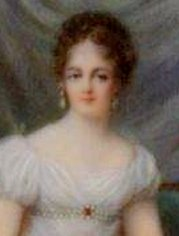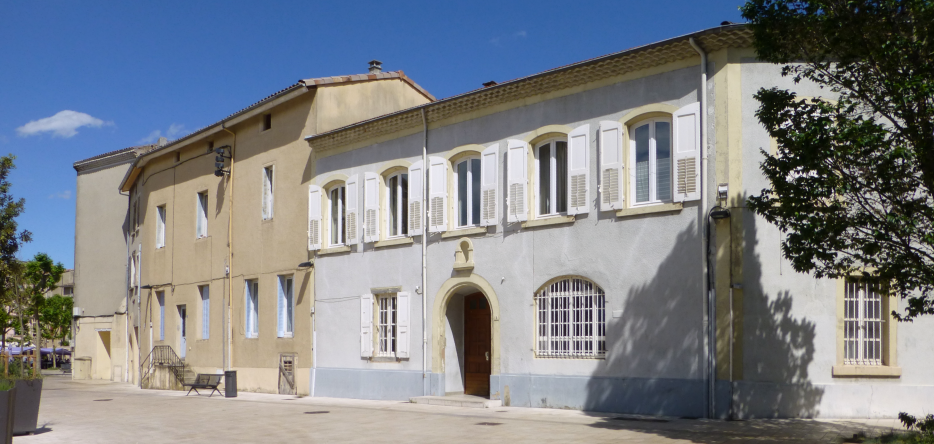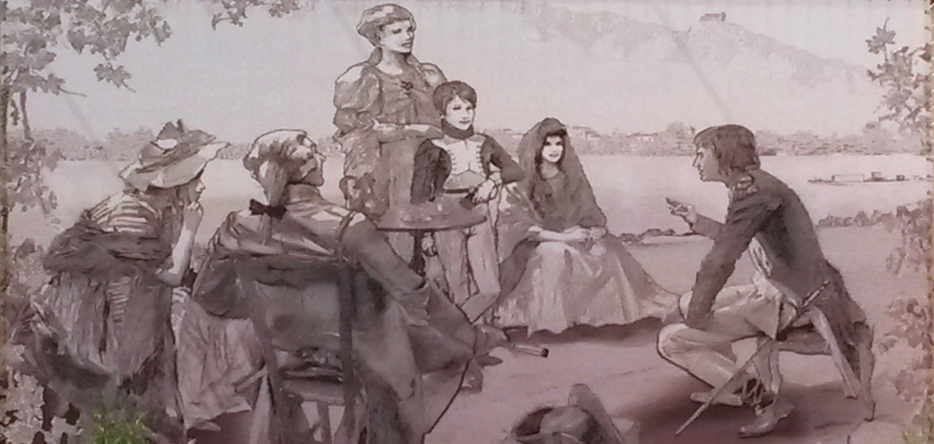Napoléon Bonaparte in Valence
The city of Valence was founded by the Romans in 121 BC after the invasion of Transalpine Gaul. Located in the center of the Rhône corridor, on the heights of the left bank of the river, it was in 1785 on the western border of the province of Dauphiné and had a population of approximately 7,000 (9,000 including the suburb).
Since its founding, its strategic position had made Valence an important military center. From 1783, the city, which had financed the creation of a training ground and the installation of an artillery school (transferred from Besançon), had been hosting two battalions of the prestigious "La Fère Artillerie" regiment.
1785-86: A young officer learning his trade as an artilleryman
It was on November 3, 1785 (some authors say the 6th) that the young second lieutenant Napolionne de Buonaparte arrived in Valence (a city he had already passed through at the end of December 1778 with his brother Joseph and their father, on the way to the Autun College), from the Paris Military School , along with his classmate Alexandre des Mazis.
There he joined the La Fère Artillery Regiment, commanded by Chevalier Louis-César de Lance, artillery colonel with the rank of brigadier in the King's armies, and the Valence Artillery School, then headed by Mr. Bouchard, field marshal. Bonaparte was assigned to the bombardier company of Captain Jacques-Philippe-François de Masson d'Autume (who would be later, upon his return from emigration in 1803, appointed by the First Consul curator of the library of the Artillery and Engineering Training School in Metz).
Napoleon's salary was 1,120 French Livres per year (800 paid by the Royal Treasury, 120 by the provinces, and 200 from the School's funds as an officer from the Military School who had not yet reached the rank of captain), and he was responsible for his own accommodation, food, and all other necessities.
For this, he moved in with Miss Marie-Claudine Bou, a single woman in her fifties, who ran a café-circle at 48 Grande-Rue , at the corner of Rue du Croissant [now Rue du Lieutenant Bonaparte], and rented rooms upstairs. It cost him 8 Livres and 8 Sols per month for a room whose windows opened onto the Grand'Rue, almost opposite the Maison des Têtes, whose façade, blending Flamboyant Gothic and Italian Renaissance styles, was covered with sculptures and grimacing statues.
One of the young lieutenant's first visits, armed with a letter of recommendation signed by Monsignor Yves Alexandre de Marbeuf, Bishop of Autun and nephew of the former Governor of Corsica, was to Mr. Jacques de Tardivon, Abbot General of the Order of Saint-Ruf. The latter received him very graciously in his abbey [of which only the portal remains today ], then admitted him assiduously to his evenings and dinners, thus introducing him to the world.

This is how he was received into the good families of Valence society, where he was not insensitive to the charm of the young ladies belonging to it:
- At the home of Joseph Starot de Saint-Germain, a former explorer and companion of Bougainville who had became a tax farmer, who owned a private mansion on the Côte des Cordeliers, he fell in love with his daughter Louise Françoise Adélaïde, so much so that he boldly asked her father for her hand in marriage. The latter, who had legitimized the child—the natural daughter of King Louis XV—at birth, refused what he considered a misalliance, as this young, penniless artillery lieutenant had no future, according to him... Adélaïde would marry her cousin Jean-Pierre Bachasson de Montalivet, Napoleon's future minister, in 1797.
- At the home of Madame de Laurencin, both in her mansion on Rue de l'Equerre and at the Castle of Champfort , he enjoyed the company of his daughter, the blonde Amélie.
- At the home of Mrs Philippe Grégoire du Colombier, a 54-year-old woman from Lyon, born Anne Carmaignac, educated and distinguished, he noticed the daughter Charlotte Pierrette Anne, known as Caroline, older than him (she was born in 1761); whether at the family hotel in town or at the Basseaux estate near Etoile-sur-Rhône, the young people formed a platonic relationship, à la Jean-Jacques Rousseau, which led them to a few walks in the meadows and orchards adjoining the Basseaux, with cherry picking as a bonus... Caroline would marry Pierre-Ignace de Garempel de Bressieux, a former captain in the Lorraine regiment, in 1792; she would maintain a regular correspondence with Napoleon, who would appoint her lady-in-waiting to Madame Mère (Napoleon's mother) in 1808.
Aware of his shortcomings, Napoleon did not hesitate to spend some of his meager resources on dance and posture lessons from a certain Mr. Dautel.
Every day, he had breakfast at Father Courriol's, a pastry chef and roaster at the corner of Rue Briffaut and Rue Vernoux, where he bought small hot pies for 1 sol each. He had lunch with his friend Des Mazis either at Courriol's or with the other lieutenants at Charles Geny's, who had run the Trois Pigeons Inn at 3 Rue Pérollerie since 1775 , and dined there every evening with the officers of the regiment. On December 4, 1795, it was at the Ecu de France Inn , rue Madier de Montjau, that he celebrated Saint Barbara, patron saint of artillerymen, at a banquet.
As for spiritual nourishment, the young Bonaparte read extensively, particularly Rousseau, and frequented, with several comrades, the literary study of Pierre Aurel, a bookseller who held a private salon for artillery officers, on the ground floor of a house located at the corner of Place des Clercs and Grand'Rue .
In the absence of military premises dedicated to teaching, it was at the Cordeliers Chapel , which had been made available to the artillery school, that Napoleon attended drawing and wash painting classes with master Jean-François Séruzier, and mathematics classes with Henri-Sébastien Dupuy de Bordes.
On January 11, 1786, deemed "instructed in the subjects of his service" after a three-month internship, Napoleon Bonaparte served as an officer at the guard post of Place des Ormeaux [44.93116, 4.88971].

On August 12, 1786, Napoleon left with his entire battalion for Lyon, where a silk workers' strike had just broken out. He arrived there on the 15th, his seventeenth birthday. In the "capital of the Gauls", he submitted a dissertation to the local Academy on the following topic, which was submitted for examination: What are the sentiments that should be most recommended in order to make man happy?
On August 30, he returned to Valence, leaving on September 1, having obtained his first leave of absence allowing him to return to Corsica.
Subsequent stays and visits to Valence
Napoleon Bonaparte would subsequently return to Valence, either for short stays or during trips to Provence, Corsica, or Italy. Here are the dates:
- Between September 15 and 30, 1787, he returned to Valence on his way to Paris.
- Between December 5 and 25, 1787, on his way to Ajaccio for his second stay, he stayed with Miss Bou.
- At the end of May 1788, he returned to Valence to rejoin his regiment, which had left for Auxonne.
- Between September 11 and 20, 1789, on his way to Corsica for his third stay and his second semester leave, he visited Madame du Colombier and the Abbé de Tardivon.
- From February 6 to 8, 1791, on his return from Corsica, he stayed in Valence on his way to Auxonne with his brother Louis. He left on foot for Serves and Saint-Vallier, from where he wrote to his uncle Joseph Fesch, then scribbled "Reflections on Love".
- On June 16, 1791, appointed first lieutenant in the 4th Artillery regiment of Valence, Napoleon entered the garrison with his brother Louis.
On July 17, a begging woman, to whom he had just given alms as she left mass at the church of Church of Saint John the Baptist , predicted a crown for him.
During this stay, he became friends with Jean-Pierre Bachasson de Montalivet (future mayor of Valence, prefect, Count of the Empire, and Minister of the Interior), whose family owned a mansion in Valence and a castle in Montmeyran .
His republican convictions also led him to serve as secretary of the Society of Friends of the Constitution, which met in the former Saint Ruf Chapel , rue Saint-James.
Napoleon left Valence on August 31 for his fourth stay in Corsica. - Between May 15 and 23, 1792, returning from Corsica, he passed through Valence again to reach Paris, arriving on the 28th.
- On September 12 or 13, 1792, sailing down the Rhône with his sister Elisa, he stopped in Valence en route to his fifth stay on the "Isle of Beauty" (Corsica). He met Mrs Mésangère and Miss Bou.
- From July 7 to 9, 1793, he joined General Jean-François Carteaux in Valence to organize a gunpowder convoy.
- He passed through Valence on August 23, 1793, coming from Avignon and on the road to Auxonne, which he reached on August 28.
- On September 3, 1793, Captain Bonaparte passed through Valence by boat, having obtained command of the artillery at the Siege of Toulon from General Carteaux.
- From May 11 to 14, 1795, returning from Italy accompanied by his aide-de-camp Jean-Andoche Junot, he stayed with Madame de Sucy at 25 or 29 rue Farnerie.
- On March 18, 1796, he passed through Valence on his way to Toulon and then to Italy, where he would brilliantly distinguish himself.
- On May 7, 1798, on his way to Toulon and Egypt, he sailed down the Rhône and passed through Valence.
- On October 12, 1799, returning from the Egyptian expedition, he met once more Miss Bou and the people of Valence.
- His last visit was of April 24, 1814 when on his way to exile on the Island of Elba he crossed the city escorted by Austrian troops and met there Marshal Augereau.
A life-size bronze statue of the young Lieutenant Bonaparte reading , the work of sculptor Jean-Paul Ravit, was inaugurated in September 2010 on Place Porte-Neuve. It was the first statue of Napoleon Bonaparte to be created in 150 years!
At the corner of Grande Rue and Rue du Lieutenant Bonaparte, there is a mural depicting our young officer in conversation in July 1791 on the banks of the Rhône with Simon de Sucy and his friends from Valence, Amélie de Laurencin, Adélaïde de Saint-Germain, and Caroline du Colombier, in the presence of the young Louis Bonaparte.

This fresco overlooks a fountain , which also recalls the future Emperor's stays in Valence.
Photos credits
Photos by Lionel A. Bouchon.Photos by Didier Grau.
Photos by Michèle Grau-Ghelardi.
Photos by various authors.